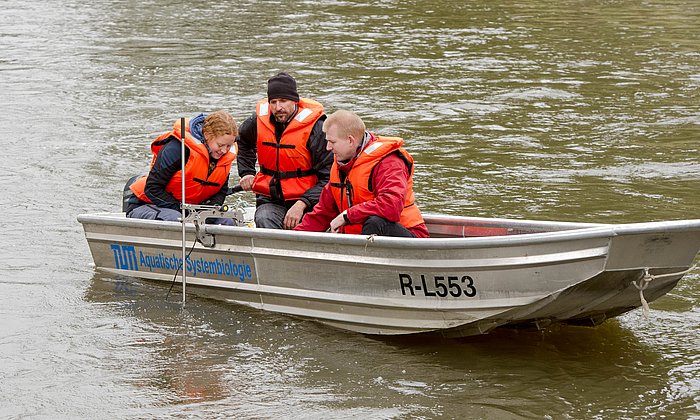Matching power plants to ecosystems – an interview with “FIThydro” project manager Peter Rutschmann
Large-scale initiative for ecologically compatible hydropower

Hydroelectric power seems to be an increasingly contentious topic in Europe. Why is this?
Back in 2000, the European Water Framework Directive stipulated that a good or very good ecological status must be achieved for all bodies of water. A key factor here is ensuring the undisturbed migration of organisms and sediment transport. We are now entering a phase where concrete plans have to be realized. At the same time, the concessions for many hydroelectric power plants are expiring – these are facilities that were built decades ago and do not yet meet the requirements of the Directive.
Can’t these hydroelectric power plants be modified to allow the migration of organisms?
Yes, the majority can be. However, there is a lot of debate about how much passage is required to ensure sustainable populations. One reason, why these conflicting interests are not easy to balance, is: Even though we have been using hydroelectric power for a long time, we still don’t know enough about many aspects of this technology. For example, there is very little scientific evidence documenting the number of species-specific fish that are harmed by specific types of hydroelectric power plants and the impact this has on the survival of entire populations.
In addition, the purpose of some plants and subsequently the way they are used is changing as we transition to a greener energy mix. Energy storage systems that had previously been used to balance out energy fluctuations in the long term are now being deployed as short-term solutions when wind turbines come to a standstill. This means that water levels can drop very quickly, causing juvenile fish to be stranded on gravel banks.
What issues do you want to address in the “FIThydro” research project?
We want to find out which technologies and concepts provide the best solutions for different scenarios. For example, there are two ways of preserving fish populations. You either protect the animals from the plant’s turbines or you make sure that the population can regenerate effectively. To do this, you have to make provisions for new spawning grounds, for example by reconnecting old tributaries to a main body of water.
We have to find out what works best at different locations for which animals and how much it will cost. In order to do this, we are also developing a new ultrasound technology at TUM that will enable us to determine the position, swimming routes, size and even the type of fish from a distance of several hundred meters without having to fit transmitters to the animals.
However, investigating all potential scenarios in Europe sounds like a huge task.
We are analyzing seventeen test case sites, each with different power plant set-ups and different challenges. We have selected four regions for this that represent the whole of Europe: Scandinavia as the largest producer of hydropower, the Alps region with its high water drops, the Iberian Peninsula as a dry region and France and Belgium representing the European Plain. All of these areas have their own unique characteristics with regard to river topographies, ecosystems and energy management. Each country’s sense of environmental awareness also differs, which is why we have social scientists involved in our project in addition to engineers and natural scientists.
What happens after the study? Not all power plant operators want to read dense academic papers.
We aim to create an online tool that can be used to plan and evaluate hydroelectric power plants. Once users have entered information about the power plant and its surroundings, the system will then determine the risk to the fish living there and evaluate the measures promising the most benefits to the ecosystem while enabling the power plant to operate cost effectively. This will enable us to find solutions that are grounded in science and factor in the interests of all stakeholders.
Do you think this will lead to more hydroelectric power plants being built?
The greatest potential for new sites is mainly in Southeast Europe. However, expansion isn’t the core focus of this project. It is about a much more fundamental issue. We live in an environment that has been and still is being massively changed by humans. Our aim is to put a flexible, professional management system in place that will minimize ecological impacts.
More Information:
Thirteen research institutes and thirteen companies in Austria, Belgium, Estonia, France, Germany, Norway, Portugal, Spain, Switzerland and the UK are taking part in the “Fish Friendly Innovative Technologies for Hydropower (FIThydro)” research project. The initiative is coordinated by the Chair of Hydraulic and Water Resources Engineering at the Technical University of Munich (TUM). TUM’s Chair of Aquatic Systems Biology, Chair of Agricultural Production and Resource Economics, Chair of Non-destructive Testing as well as the Munich Center for Technology in Society (MCTS) are also involved. The project has received EUR 7.2 million in funding from the EU research program “Horizon 2020” and the Swiss National Science Foundation (SNF).
Contact:
Prof. Dr. Peter Rutschmann
Technical University of Munich (TUM)
Chair of Hydraulic and Water Resources Engineering
Tel: +49 89 289 23161
peter.rutschmann@tum.de
Technical University of Munich
Corporate Communications Center
- Klaus Becker
- klaus.becker@tum.de
- presse@tum.de
- Teamwebsite




